G-Force CORSAIR 180 User manual

CORSAI
R
18
0
MANUAL V1.1 12/05/13

CORSAIR 180
MANUAL
2
IMPORTANT NOTICES 03
ASSEMBLING OF THE PARAMOTOR 05
HARNESS AND DISTANCE BARS 07
ASSEMBLING OF THE PROPELLER 10
ASSEMBLY INSPECTION 11
TECHNICAL DATA OF THE ENGINE 12
CARBURETOR – FUEL AND OIL 14
IGNITION AND ELECTRIC 15
JOYSTICK 17
PRE-FLIGHT CHECK 18
SPARE PARTS LIST 19
DIAGNOSING AND STARTING A FLOODED ENGINE 26
REGULAR CHECKS AND MAINTENANCE 28
TERMS OF GUARANTEE 29
WARRANTY ZERTIFICATE 30

CORSAIR 180
MANUAL
3
IMPORTANT NOTICES
* * C O N G R A T U L A T I O N S * *
Thank you for choosing an excellent paramotor. Please take the time to read this
manual carefully, with this manual we will try to give advice on the maintenance and
operation that will help you have a reliable paramotor and to preserve your
investment.
Furthermore, we invite you to give this manual with the paramotor if you sell it, so it
can be useful for the next owner as well. The manufacturer and the resellers are
ready to answer your questions and, if necessary, to solve problems, because the
safety of yourself and the others is the most important thing for us. When you will
receive the motor, it will already have overcome a test of 1 hour in the factory,
verifying the operation of all the components and the operation to every speed. All
the paramotors are tested before the delivery. We reserve the right to change
specifications, components, details of the motor, in relationship to the model in
production without incurring in some obligation. The reliability, the performances and
the duration of your paramotor will also depend on your understanding of the correct
maintenance and operation of the engine. This manual describes the paramotor, its
installation, use and control.
This PPG is not covered by product liability insurance. Do not start it or fly it
unless you are willing to assume all risks inherent in the sport of Powered
Paragliding and all responsibility for any property damage, injury or death
which may result from the use of this product.

CORSAIR 180
MANUAL
4
You must be aware that any engine can fail and breakdown at any moment,
this could lead a landing in less than ideal areas with the possibility of injury to
the pilot or other people. Any powered paramotor must only fly in permitted
areas, and never to fly low above a crowd of people. Inhabited zones, water,
and areas that are difficult to land should be avoided, always remember that
the engine could stop.
Some atmospheric conditions can cause the engine to perform differently than
normal. Before beginning every flight, you must test the paramotor on the
ground. Start the engine on a flat surface that is free from stones, sand or
small parts that could be sucked in by the propeller. Be sure any persons
nearby are well clear off the thrust from the propeller and not near the
propeller at any time the motor is running. A good safety distance is 50 meters
for all directions of projection of the propeller and 20 meters for the others
directions.
Do not use a paramotor that has not been correctly maintained or not been
used for some time, or if you know that is not in good condition. The use of
not original spare parts can make the paramotor dangerous and immediately
voids the warranty. Changes to the reduction or propellers can reduce safety
and reliability of the aircraft. Before every use or test, check the condition of
the propeller and the torque of bolts of the propeller. If the propeller is
damaged do not use it, this can lead to a breakup of the propeller in rotation
or to strong vibrations that will transmit to the motor and may cause damage
or loosen bolts or components.
Never use the motor without propeller or without reduction drive.

CORSAIR 180
MANUAL
5
FRAME
The frame consists of:
-a.) central module
-b.) cage
-c.) 2x long supports
-d.) 4x middle supports
Top position: long supports
Middle position: middle supports
Bottom position: middle supports
Assemble the complete cage and
close all velcro straps
ASSEMBLING OF THE PARAMOTOR

CORSAIR 180
MANUAL
6
Insert assembled cage first in top position
after that insert middle and bottom position.
Close bottom velcro straps on both sides.
Close netting with carabineer on both sides.

CORSAIR 180
MANUAL
7
Harness has to be connected with the special
buckles.
Connect harness with both buckles to the frame.
ASSEMBLING OF THE HARNESS AND THE DISTANCE BARS

CORSAIR 180
MANUAL
8
Fix the distance bars with the nut.
Distance bars are moveable vertically and
horizontally.
Fix the shoulder strap correctly to the harness.

CORSAIR 180
MANUAL
9
ADJUSTING OF THE HARNESS
The best way to familiarize yourself with the harness and your personal flying
position is to use a simulator.
Sit in the harness and adjust the shoulder straps correctly. The weight should be
constantly shared on the shoulders. Find your seat position and adjust the straps
accordingly to sit relaxed.
The shoulder straps are adjusted depending on pilot weight. The flight position is
optimal when the propeller shaft line is 5 ° to a maximum of 10 ° below the horizontal
line.
horizontal line
propeller shaft line

CORSAIR 180
MANUAL
10
On the CORSAIR 180 paramotor is mounted a HELIX carbon propeller
Mount the propeller with the six M8 screw with a torque of 10Nm.
Please use only original propellers otherwise you lose your warranty.
ASSEMBLING OF THE PROPELLER

CORSAIR 180
MANUAL
11
It is very important to fully inspect the assembly of your paramotor to find and
remedy any potential problem areas before proceeding.
The inspection should contain, at a minimum, the following items:
Review each assembly step above
Examine all nuts, bolts, and fasteners for security
Check the harness for correct mounting, that all straps are secure, that
there are no twists on any straps
Examine prop cage for correct assembly, that it is strong, the netting is
tight and on the correct side
Check that nothing can get in the prop. The prop should clear the cage
by same distance at all points.
Check the fuel tank and fuel delivery system.
Check for correct mounting of prop, and correct torque of prop bolts.
ASSEMBLY INSPECTION

CORSAIR 180
MANUAL
12
TECHNICAL DATA OF THE ENGINE
Engine 1 Cylinder 2-Stroke Engine
Cooling By Air
Bore 65 mm
Swept Volume 172.5 cm³
Power 25 PS bei 7900 U/Min
Thrust 70 kg
Cylinder Aluminium with Nikasil Coating
Compression 11 : 1
Piston HQ graphite , 2 rings chromed
Carburetor Walbro
Air-Filter Air box
Ignition Induktiv IDI
Spark Plug NGK BR9ES
Spark Plug Cap 5k Ω
Reduction Poly V-Belt
Reduction Ratio 1:2.88
Propeller Helix H30F 1,25m L-M-09-2
Starter Manual Starter
Exhaust Stainless steel with silencer
Consumption 3.0-3.5 L/hour at 30 kg Thrust
Weight Engine 16 kg
Propeller Direction Counter Clockwise
Tank 12 L
Total Weight of Paramotor 28.7 kg

CORSAIR 180
MANUAL
13
TIGHTENING TOURQUE
TIGHTENING TOURQUE VALUE
FOR ENGINE BOLTS AND SREWS M N.m Kgf.m Lbf.ft
Locking
compound
HEAD NUTS 7 14 1,4 10,36
CRANKSHAFT NUT – CLUTCH SIDE 12 60 6 44,4
CRANKSHAFT NUT – IGNITION
SIDE 10 40 4 29,6
PROPELLER CENTRAL SCREW 10 40 4 29,6 Loctite 243
SPARK PLUS 20 2 14,8
CRANKCASE SCREWS 6 8 0,8 5,92
CARBURETOR LOCKING SCREWS 6 8 0,8 5,92
INTAKE MANIFOLD LOCKING
SCREWS 6 8 0,8 5,92
MUFFLER STUDS NUTS 6 10 1 7,4 Loctite 270
SILENCER LOCKING SCREWS 8 15 1,5 11,1 Loctite 243
MUFFLER LOCKING SCREWS 8 15 1,5 11,1 Loctite 243
STANDARD TIGHTENING TORQUE VALUES N.m Kgf.m Lbf.ft
5 mm Bolts and nuts 6 0,6 4,44
6 mm Bolts and nuts 10 1 7,40
8 mm Bolts and nuts 25 2,5 18,50
10 mm Bolts and nuts 45 4,5 33,30
12 mm Bolts and nuts 55 5,5 40,70

CORSAIR 180
MANUAL
14
CARBURETOR – FUEL AND OIL
IMPORTANT INFORMATION
We recommend using super gasoline and full synthetic oil (Castrol TTS) at 2%.
Mix fresh fuel and oil before each flying session. Store your fuel/oil mixture in
an approved, sealed container. Dispose of fuel/oil mixture that is older than 1
month.
During running in we recommend using 2.5% oil mixture and use only full
power during starting.
Mixture table:
The fuel oil mixture should not be older than 1 month!
fuel 95/98 octan
full synthetic oil
Castrol TTS
full synthetic oil
Castrol TTS
LITER 1:40 (2.5%)during
running in time
ml
1:50 (2%)
normal use
ml
0,5
1
2
3
4
5
10
13 ml
25 ml
50 ml
75 ml
100 ml
125 ml
250 ml
10 ml
20 ml
40 ml
60 ml
80 ml
100 ml
200 ml

CORSAIR 180
MANUAL
15
IGNITION AND ELECTRIC
Spark Plug: NGK BR9ES

CORSAIR 180
MANUAL
16

CORSAIR 180
MANUAL
17
JOYSTICK
We supply with this paramotor a special build joystick which is a novum in the
paramotor market.
Since it’s important to know how to stop the engine once it’s started, let’s cover
“Stopping the Engine” first. To stop the engine, simply depress the “STOP” button
and hold it until the engine comes to a complete stop.

CORSAIR 180
MANUAL
18
PRE-FLIGHT CHECK
THE FOLLOWING POINTS SHOULD BE CARRIED OUT BEFORE EACH START!
01 VISUAL INSPECTION OF CAGE AND FRAME FOR FRACTURES
02 PROPELLER HUB WITHOUT CLEARANCE?
03 REDUCTION GEAR LEAK-PROOF ?
04 EXAMINATION OF EXHAUST AND MOTOR RUBBER ELEMENTS!
05 PETROL FILTER UNPOLLUTED?
06 MOTOR, CARBURETOR AND TANK ARE LEAK-PROOF?
07 SUFFICIENT SUPPLY OF FUEL AND OIL IN FUEL (DON’T USE
MIXTURE OLDER THAN 1 MONTH) ?
08 PILOT SUSPENSION UNDAMAGED ?
09 CANOPY UNDAMAGED ?
10 GAS LEVER POSITION – CHECK THE FREE MOVEMENT!
11 VENTILATED TANK LID ON TANK?
12 PROPELLER CLEAR – START PARMOTOR – NO PERSONS NEAR
BY STARTING THE PARAMOTOR
13 CARRY OUT A TEST AT FULL THROTTLE AFTER WARMING UP!
14 TEST THE SWITCH-OFF FUNCTION!
15 PILOT PROPERLY HOOKED IN?
16 WIND DIRECTION AND WIND FORCE?
17 TAKE OFF AREA CLEAR ?
18 TEST FOR LEAKS?

CORSAIR 180
MANUAL
19
SPARE PARTS LIST

CORSAIR 180
MANUAL
20
Table of contents
Other G-Force Paramotor manuals
Popular Paramotor manuals by other brands
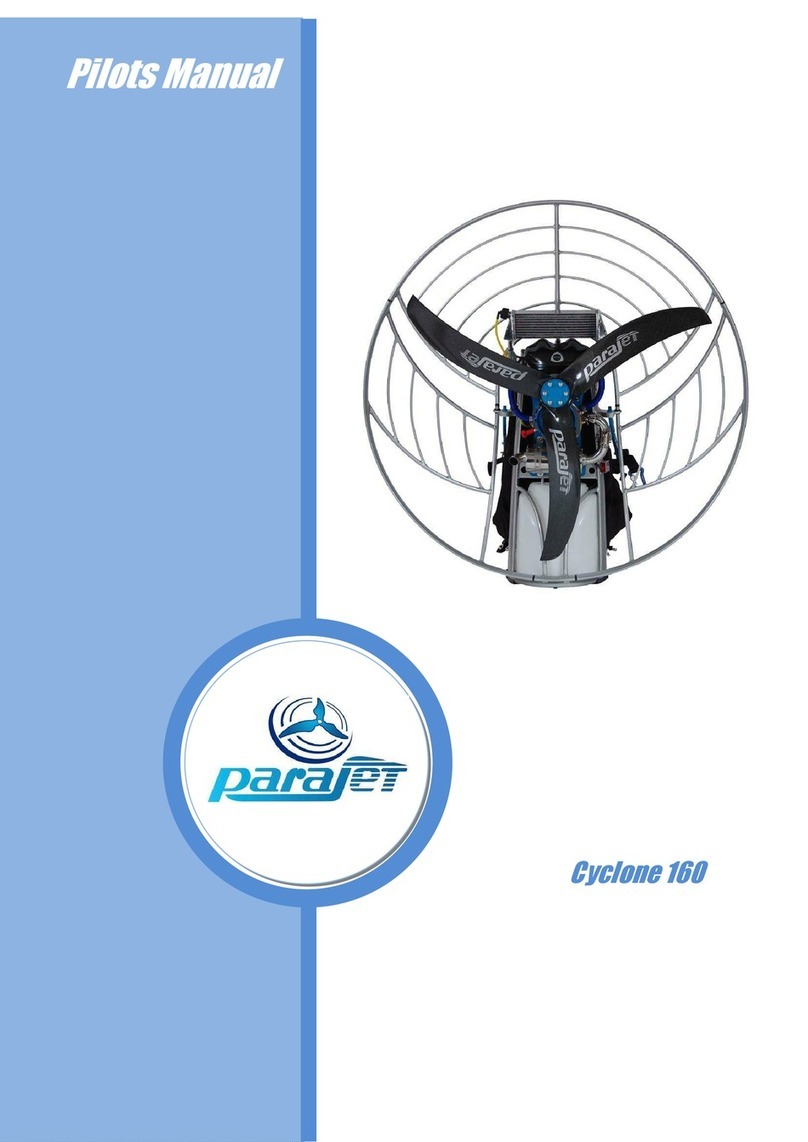
Parajet
Parajet Cyclone 160 Pilot's manual
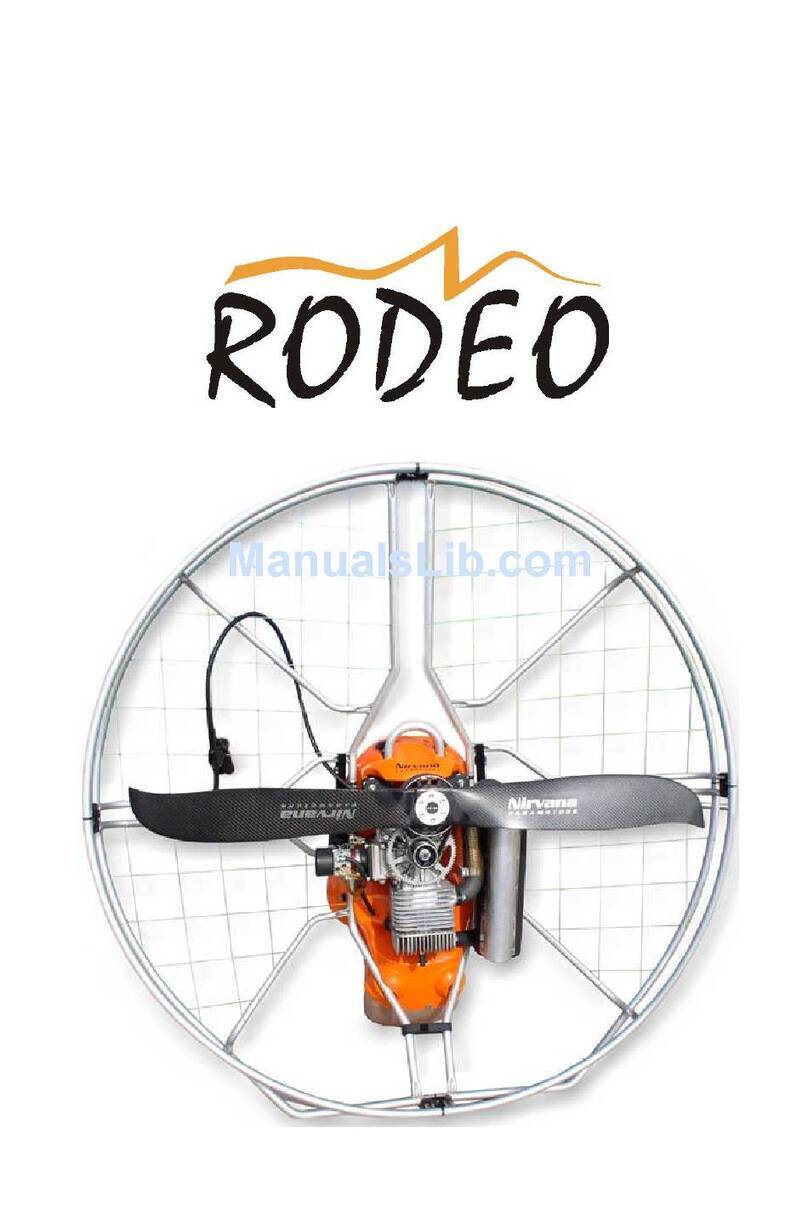
Nirvana Paramotors
Nirvana Paramotors RODEO Assembly and maintenance manual
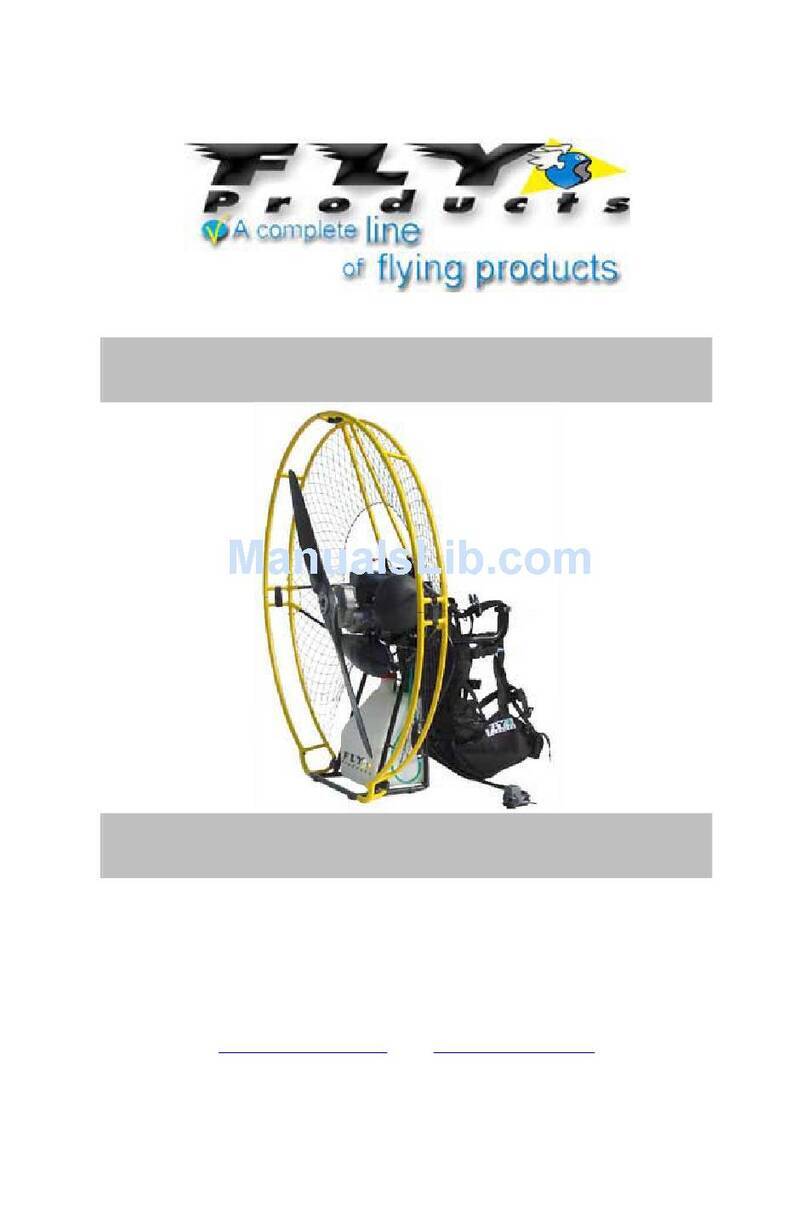
Fly Products
Fly Products POWER JET owner's manual
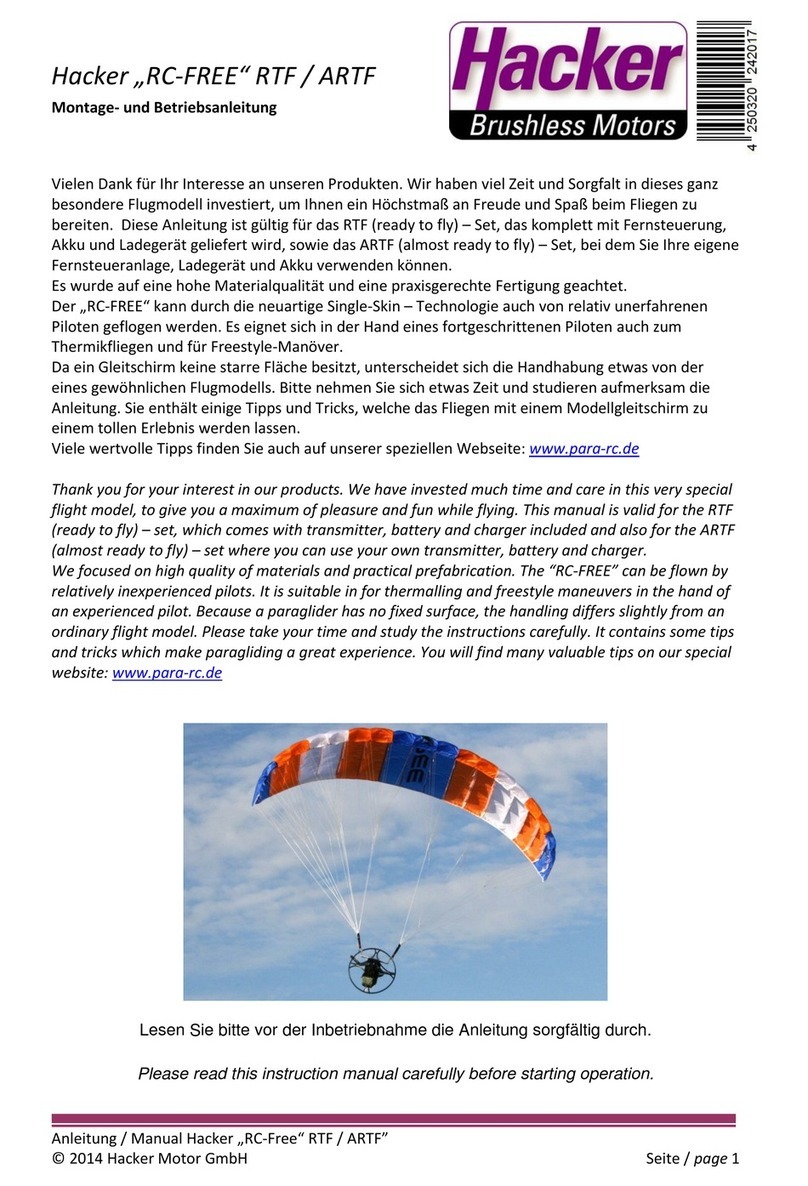
Hacker
Hacker RC-FREE RTF instruction manual
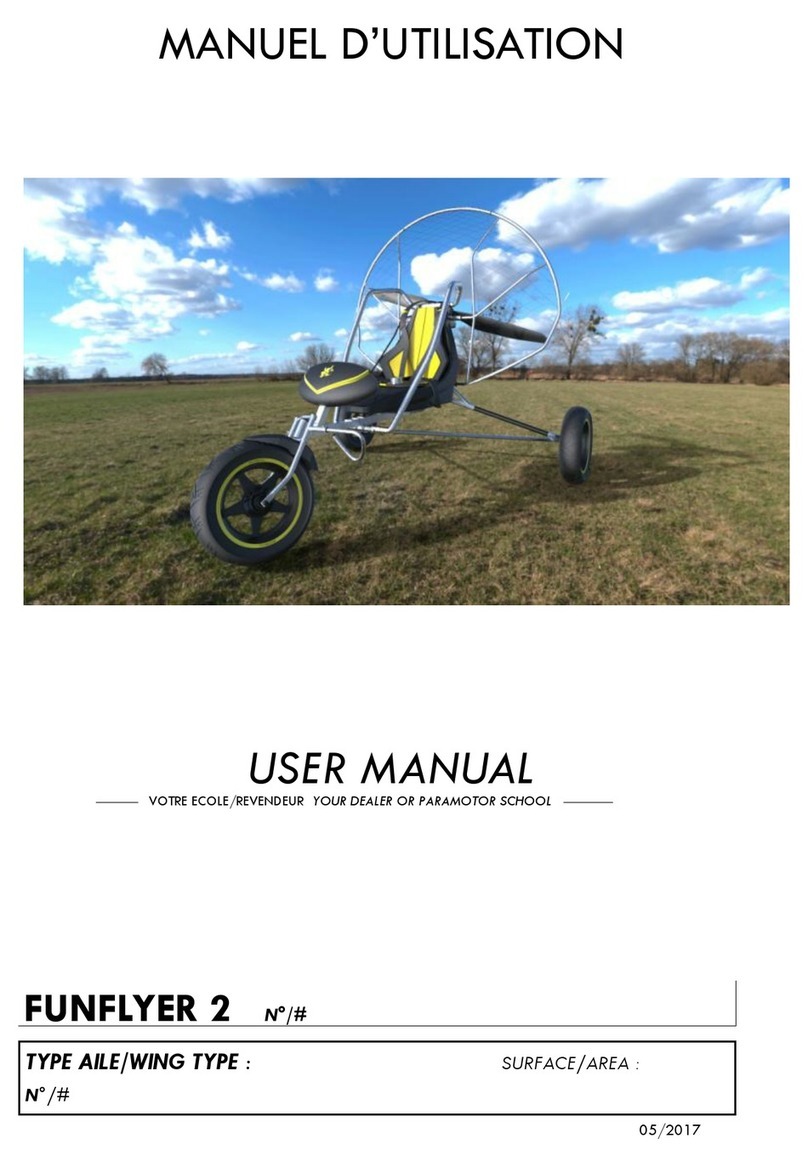
Adventure
Adventure FUNFLYER 2 user manual
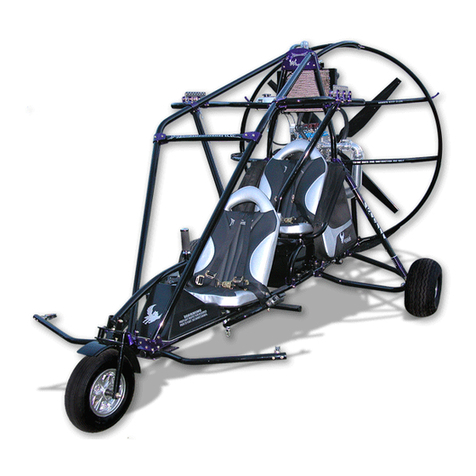
Powrachute
Powrachute PEGASUS 582 Pilot operating handbook
